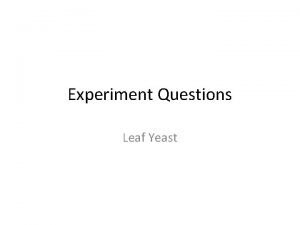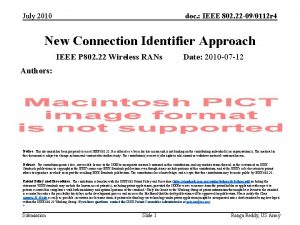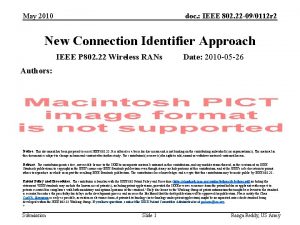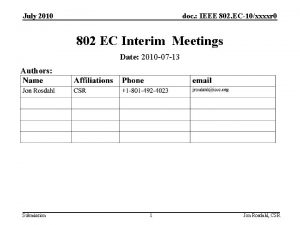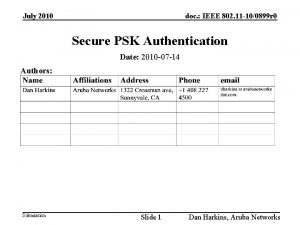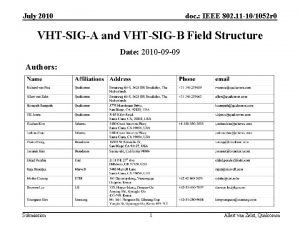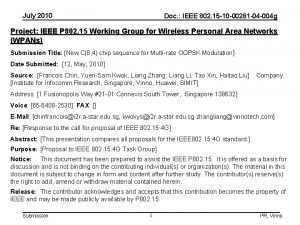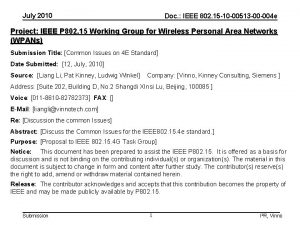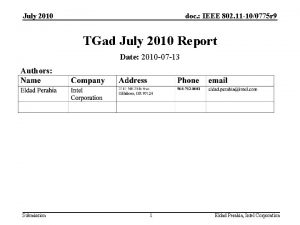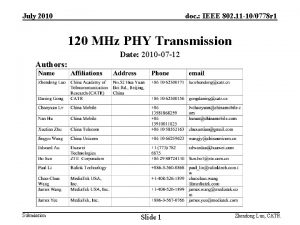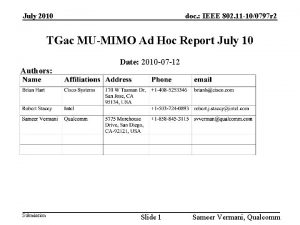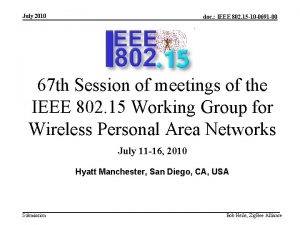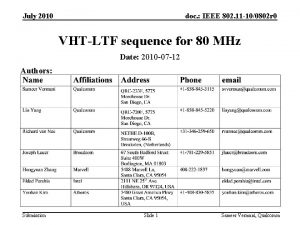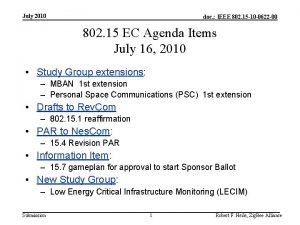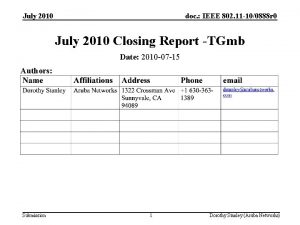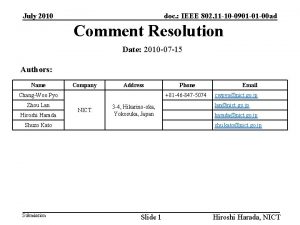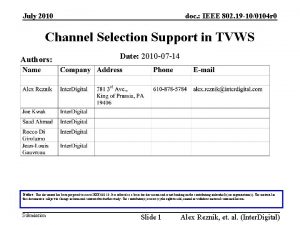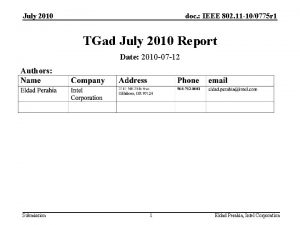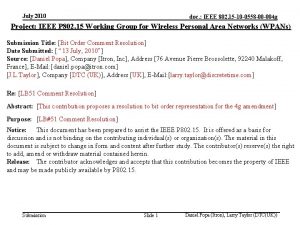July 2010 doc IEEE 802 22 090112 r























- Slides: 23

July 2010 doc. : IEEE 802. 22 -09/0112 r 3 New Connection Identifier Approach IEEE P 802. 22 Wireless RANs Date: 2010 -07 -07 Authors: Notice: This document has been prepared to assist IEEE 802. 22. It is offered as a basis for discussion and is not binding on the contributing individual(s) or organization(s). The material in this document is subject to change in form and content after further study. The contributor(s) reserve(s) the right to add, amend or withdraw material contained herein. Release: The contributor grants a free, irrevocable license to the IEEE to incorporate material contained in this contribution, and any modifications thereof, in the creation of an IEEE Standards publication; to copyright in the IEEE’s name any IEEE Standards publication even though it may include portions of this contribution; and at the IEEE’s sole discretion to permit others to reproduce in whole or in part the resulting IEEE Standards publication. The contributor also acknowledges and accepts that this contribution may be made public by IEEE 802. 22. Patent Policy and Procedures: The contributor is familiar with the IEEE 802 Patent Policy and Procedures http: //standards. ieee. org/guides/bylaws/sb-bylaws. pdf including the statement "IEEE standards may include the known use of patent(s), including patent applications, provided the IEEE receives assurance from the patent holder or applicant with respect to patents essential for compliance with both mandatory and optional portions of the standard. " Early disclosure to the Working Group of patent information that might be relevant to the standard is essential to reduce the possibility for delays in the development process and increase the likelihood that the draft publication will be approved for publication. Please notify the Chair Apurva N. Mody as early as possible, in written or electronic form, if patented technology (or technology under patent application) might be incorporated into a draft standard being developed within the IEEE 802. 22 Working Group. If you have questions, contact the IEEE Patent Committee Administrator at patcom@iee. org. > Submission Slide 1 Ranga Reddy, US Army

July 2010 doc. : IEEE 802. 22 -09/0112 r 3 Abstract This contribution proposes a new way to treat connection identifier (CIDs) in the 802. 22 MAC. The purpose of this method is to reduce overhead, optimize processing, and reduce storage requirements for maintaining CPE context at both the BS and CPE. Submission Slide 2 Ranga Reddy, US Army

July 2010 doc. : IEEE 802. 22 -09/0112 r 3 Current (in v 3. 0) CID Description – Table 288 (where m = max # of supported CPEs) CID Value Description Initial Ranging CID 0 x 000 Used by CPE and BS during initial ranging Basic CID 0 x 001 - m The same value is assigned to both the DS and US connection. Primary Management CID m+1 – 2 m The same value is assigned to both the DS and US connection. Multicast Management CID 2 m+1 – 3 m Shall only be used in the DS direction by the BS. Allows management commands to be addressed to a group of CPEs Transport CIDs and Secondary Management CIDs 3 m+1 – 0 x. EFE For the secondary management connection, the same value is assigned to both the DS and US connection. Multicast Polling CIDs 0 x. F 00 – 0 x. FFD A CPE may be included in one or more multicast polling groups for the purposes of obtaining bandwidth via polling. Theses connections have no SF. Padding CID 0 x. FFE Used for transmission of padding info by CPE or BS. Broadcast CID 0 x. FFF Used for broadcast information transmitted on the downstream to all CPEs. Slide 3 Ranga Reddy, US Army Submission

July 2010 doc. : IEEE 802. 22 -09/0112 r 3 New Method for Treating CID • Proposal is to break up the CID into 2 entities: – Station ID (9 MSB): ID that is unique to CPE or multicast group – Flow ID (3 LSB): ID that identifies a traffic flow that is mapped to a particular Station ID – The figure below depicts this breakdown Submission Slide 4 Ranga Reddy, US Army

July 2010 doc. : IEEE 802. 22 -09/0112 r 3 Station ID is broken down as follows. . . • Station ID space split up between CPEs and Multicast Groups, using m, the maximum # of CPEs supported in a cell. – – Submission With a 9 -bit Station ID, 512 stations are possible. CPE Station ID: 0 x 001 – m Multicast Group ID: m+1 – 0 x 200 Station ID = 0 x 000 (see Slide 8), we’ll call this the Cell Station ID Slide 5 Ranga Reddy, US Army

July 2010 doc. : IEEE 802. 22 -09/0112 r 3 Flow ID (1/2) • Flow ID is 3 bits long. It’s treated differently, based on whether or not the Station ID is a CPE (Unicast) Station ID or a Multicast Station ID. 1. When Station ID is Unicast SID (an individual CPE): – – 000 = Basic Flow 001 = Primary Management Flow 010 -110 = Unicast Transport Flows 111 = Secondary Management Flow if Secondary Management connection is enable, or reserved for vendor/operator specific use 2. When Station ID is Multicast SID (a group of CPEs): – – 000 = Multicast Polling Flow 001 = Multicast Management Flow 010 -110 = Multicast Transport Flow 111 = reserved 3. When Station ID is Cell SID (reserved SID for cell-wide usage): – – – Submission 000 = Broadcast Flow 001 = Initial Ranging Flow 010 -111 = reserved Slide 6 Ranga Reddy, US Army

July 2010 doc. : IEEE 802. 22 -09/0112 r 3 Flow ID (2/2) • Regardless of whether Station ID is Unicast/Multicast, suggest fixing the Transport Flows to specific scheduling services as follows: – – – 010 = BE 011 = nrt. PS 100 = rt. PS 101 = UGS 110 = reserved • The purpose of this is to reduce signaling in service flow parameter encoding/definition, e. g. we now only have to select the scheduling service the flow uses. Submission Slide 7 Ranga Reddy, US Army

July 2010 doc. : IEEE 802. 22 -09/0112 r 3 What happened to “Well Known” CIDs in Table 299? • CIDs are constructed from the Station ID + Flow ID 1. CPE Basic CID – Unicast Station ID || Basic Flow ID (000) 2. CPE Primary Management CID – Unicast Station ID || Primary Management Flow ID (001) 3. CPE Transport CID – Unicast Station ID || Unicast Transport Flow ID (010 -110) 4. Multicast Polling CID – Multicast Station ID || Multicast Polling Flow ID (000) 5. Multicast Management CID – Multicast Station ID || Multicast Management Flow ID (001) • Multicast Transport CID – Multicast Station ID || Multicast Transport Flow ID (010 -110) Submission Slide 8 Ranga Reddy, US Army

July 2010 doc. : IEEE 802. 22 -09/0112 r 3 What happened to “Well Known” CIDs in Table 299? (continued) • • Broadcast, Initial Ranging, and Padding CID are based off the “Cell Station ID” alluded to on slide 5 Broadcast CID – = Cell Station ID || Broadcast Flow ID (000) = 0 x 000 • Initial Ranging CID – = Cell Station ID || Initial Ranging Flow ID (001) = 0 x 001 Submission Slide 9 Ranga Reddy, US Army

July 2010 doc. : IEEE 802. 22 -09/0112 r 3 Why use this new approach? • The new approach is an attempt to reduce overhead and optimize use of system resources: 1. Reduce size of GMH (by 9 bits). This may not seem like much, but over many PDUs it could add up. 2. Bursts are then identified by signaling the Station ID in the DS/US-MAP IE 3. We’re suggesting using only maximum of 5 Transport CIDs per CPE, one per service class. All SF’s pertaining to (unicast/multicast) traffic can be mapped onto one of these Flow IDs. If there is prioritization differentiation within a service class, this requires the CPE, when transmitting data to take into account is current bandwidth allocation and Qo. S context when deciding how to pack/fragment MAC SDUs into PDUs for transmission 4. The new behavior is optimized, so BS’s and CPE’s only have to maintain as much information about the connections. This may be useful when handling certain operations such as Timeout or performing HO (a potential future capability), as well as reducing the memory/storage/processing requirements for a CPE’s connections at both the CPE & BS. Submission Slide 10 Ranga Reddy, US Army

July 2010 doc. : IEEE 802. 22 -09/0112 r 3 Text Proposal (1/12) 1. Introduce Station ID term into Clause 3: 3. XX Station ID (SID): an unique identifier for a CPE under the control of a BS. This can reflect a single CPE, or a group of CPEs (e. g. multicast group) 2. Introduce Flow ID term into Clause 3: 3. XX Flow ID (FID): an unique identifier for a CPE under the control of a BS. This can reflect a single CPE, or a group of CPEs (e. g. multicast group) 3. Make the following changes to CID field in GMH Table 3: • • • 4. CID field changed to FID Size of Flow ID and set to 3 bits Notes field should read “Flow ID” Also line 10, pg 30, Section 6. 8. 1. 1: change “CID” to “FID” Text for HCS calculation in Table 3 will need to be updated… Make the following changes to DS-MAP IE (Table 36, Section 6. 10. 2. 1): • • Remove If-block “IF (INCLUDE_CID)” Replace the removed If-block with one field (e. g. one DS-MAP IE refers to one stations allocation) – – – 5. Called SID Size 9 bits Notes field should read “Station ID of CPE or multicast group” Remove CID Switch Extended IE • Submission delete section 6. 10. 2. 1. 2. 2. Slide 11 Ranga Reddy, US Army

July 2010 doc. : IEEE 802. 22 -09/0112 r 3 Text Proposal (2/12) 6. Make the following changes to the CID field US-MAP IE (Table 47, Section 6. 10. 4. 1): • • 7. Change CID to SID Change size to 9 bits Notes field should read “Station ID of CPE” Also change text on lines 3 -4 page 54 in section 6. 10. 4. 1 as follows: “The FCID field carried by the US-MAP IE is associated with a unicast address or the padding CID. When specifically addressed to allocate a bandwidth grant, the FCID shall be the Basic FCID of the CPE. ” Make to following modifications to definition of RNG-RSP IEs (Table 57, Section 6. 10. 6): • • • Remove Basic CID field in Table 57 Remove Primary Management CID field in Table 57 Add a new field: – – Submission Name: “Station ID” Element ID: it’s at the editor’s discretion to specify the value for this field in the new entry Size: 9 bits Notes: “Required parameter when RNG-RSP sent in response to initial ranging” Slide 12 Ranga Reddy, US Army

July 2010 doc. : IEEE 802. 22 -09/0112 r 3 Text Proposal (3/12) 8. Remove the following IEs from REG-REQ/RSP: • • 9. 6. 10. 7. 3. 5 "# of US CIDs supported” 6. 10. 7. 3. 4 “Secondary Management CID” Need to discuss if Service Flow encoding would only need to carry only the Flow Id or Station ID || Flow ID (e. g. the whole CID). If only Flow ID, then Table 83 and 6. 10. 8. 9. 2 have to be changed • • In a SF description/definition, the CID that is to be used for mapping traffic to has to be defined. Currently this specification is 6. 10. 9. 8. 2. The CID SF parameter is set a 2 octet length, which is actually much longer than the 12 bit CID. In slide 7 of this presentation I describe mapping the transport Flow Ids to specific scheduling services (e. g. Flow ID = 010 -> BE, Flow ID = 011 -> nrt. PS, etc). This allows us to simplifying the service flow parameter encodings in 6. 10. 8. 9 So, we suggest here the following modifications to text in 6. 10. 8. 9: – – – Submission Delete CID entry in Table 83 Delete Section 6. 10. 8. 9. 2 Other modifications, especially to text in Section 6. 21, are presented later in this contribution Slide 13 Ranga Reddy, US Army

July 2010 doc. : IEEE 802. 22 -09/0112 r 3 Text Proposal (4/12) 10. Modify structure of MCA-REQ/RSP as follows: • Change row 2 of Table 114 as follows: – – – • • • Change “Multicast CID” to “Station ID” Change Length to 9 bits Change text for Description to “Station ID to represent mulitcast group that CPEs are being assigned to” Change row 4, Table 114, Description field to the following: “ 0 x 00 = transport-only mulitcast flows, 0 x 01 = management-only multicast flows, 0 x 02 = polling-only multicast flows, 0 x 03 = management & polling-only multicast flows 0 x 04 = transport/polling/management multicast flows 0 x 05 -0 x. FF = reserved” Replace row 5, Table 114, Description field with the following: “Only applicable when Multicast Group Type set to 0 x 02 -0 x 04. Byte 0 (LS Byte) = m, Byte 1 = k, Byte 2 = n, Byte 3 = reserved. An upstream allocation is made available to CPEs (see 6. 14. 3. 2) to send a Bandwidth Request @ the end of frame #N if N mod k = m, size of allocation is n” Other modifications to text in Section 6. 20 will be discussed later in this contribution. 11. Add abbreviations for Flow ID (FID) and Station ID (SID) to Clause 4 12. Modification to MIB objects specifically: wran. If. Bs. Sf. Mgmt (SF management), wran. If. Bs. Cpe. Multicast. Config. Table, wran. If. Bs. Ofdma. Phy. Downstream. Channel. Table, wran. If. Bs. Am, wran. If. Bs. User. Metrics. Table, wran. If. Bs. Cid. Metrics. Table, wran. If. Bs. Sf. Table. This modifications will be present in the another contribution handling MIB work. Submission Slide 14 Ranga Reddy, US Army

July 2010 doc. : IEEE 802. 22 -09/0112 r 3 Text Proposal (5/12) 13. Review other MAC mgmt messages to make sure the align with this process. Most other MAC messages (besides the ones listed here) don’t explicitly reference CID as a parameter of MAC message or in an IE. • No other MAC messages, besides the RNG-RSP, MCA-REQ/RSP, and SF parameter encodings reference CID directly. No other changes to MAC management message formats besides the ones slide 11 -13 in this contribution are necessary 14. Line 20, pg 117, Section 6. 11. 2. Change text on ln 19 -21 as follows: • “Each CPE’s allocation is uniquely identified by the SID in the DS/US-MAP. Since e. Each MAC PDU within that allocation is identified by a unique CIDFID, the receiving MAC entity is able to present the MAC SDU (after reassembling the MAC SDU from one or more MAC PDUs) to the correct instance of the MAC SAP. ” 15. Line 26, pg 121, Section 6. 11. 6 ignore this instance, 6. 11. 6 text for section is to be modified as per resolution to CID 140/141 16. Line 1, pg 122, Section 6. 12. Change “CID” to “FID” 17. Line 37, pg 134, Section 6. 13. 2. 3. Change “nrt. PS CIDs” to “the nrt. PS FID on a CPE” 18. Line 10, pg 135, Section 6. 14. Change “up to three dedicated CIDs” to “three dedicated FIDs” 19. Line 13, pg 136, Section 6. 14. 1. 2. Change text on lines 12 -14 as follows: • Submission “Upon detection, the BS shall provide (an implementation dependent) upstream allocation for the CPE. , The BS doesn’t respond with an allocation on the CPE’s but instead of indicating a Basic CFID. , Instead it broadcasts the broadcast CID shall be sent in combination with a CDMA_Allocation_IE, which specifies the transmit region and Code that were used by the CPE. ” Slide 15 Ranga Reddy, US Army

July 2010 doc. : IEEE 802. 22 -09/0112 r 3 Text Proposal (6/12) 20. line 26/33/35/37, pg 136 section 6. 14. 2. Make the changes to 6. 14. 2 as follows: • • Change both instances of “CID” to “FID” on line 26 Change “CID” to “FID” on line 33 Change “CID” to “FID” on line 35 Change both instances of “CID” to “FID” on line 37 21. line 48, pg 136, Section 6. 14. 3. Change “CID” to “FID” 22. line 10, pg 137 section 6. 14. 3. 1. Change “CID” to “FID” 23. line 13/pg 137 -Line 1/pg 138 section 6. 14. 3. 2. Change text as follows: • “Certain CSIDs are reserved for multicast groups and for broadcast messages, as described in Table 288 Section 11. 2. “ 24. line 3/5/6, pg 138 section 6. 14. 3. 2. Change text on lines 2 -6 on pg 138 as follows: • Line 3: “bandwidth with a CPE’s Basic CFID, the allocation is to the Polling FID (see 11. 2) for a multicast group (multicast SID) or broadcast CID (the Management FID in the Cell SID, see 11. 2). ” Line 5 -6: “When the poll is directed at to a multicast group or via broadcast CID, a CPE belonging to the polled group may request bandwidth during any request interval allocated to that CID in the US-MAP by a Request IE. “ • 25. Line 10/15/16/51, pg 141 section 6. 16. Change the text on lines 10/15/16/51 as follows: • • • Submission Line 10: Change “CID” to “SID” Lines 15 -16: “Since a CPE can have may need to service multiple upstream service flows (each with its own CFID), it makes these decisions on a per CFID or a per service Qo. S (see 6. 20) basis. ” Line 51: Change “CID” to “FID” Slide 16 Ranga Reddy, US Army

July 2010 doc. : IEEE 802. 22 -09/0112 r 3 Text Proposal (7/12) 26. line 2/5/10/11/27/32/33, pg 156 6. 17. 2. 6. 3. 1. Change the text on these lines as follows: • • Line 2: Change “CID” to “connection (see 11. 2)” Line 2: Change “Basic and Primary Management CIDs” to “Station ID (SID)” Line 5: Change “CID” to “FID” Line 10: Change “CID” to “FID” Line 11: Change “CID” to “FID” Line 26 -27: Change “obtain new Basic, Primary Management, and Secondary Management CIDs” to “obtain a new SID” Line 31 -32: Change “the Basic, Primary Management, and Secondary Management CIDs” to “the SID” Line 32 -33: Change “new Basic, Primary Management, and Secondary Management CIDs, it shall make some provision to aging out the old CIDs” to “a new SID, it shall immediately age out the old SID and associated CPE context. ” 27. line 41/43, pg 159, 6. 17. 9. Change text on lines 40 -43 as follows • 28. 29. 30. 31. “Registration is the process by which the CPE is allowed entry into the network and a CPE receives its Secondary Management CID and thus becomes manageable. To register with a BS, the CPE shall send a REGREQ message to the BS. The BS shall respond with a REG-RSP message. The REG-RSP message shall include the Secondary Management CID. ” Line 14/pg 161, Section 6. 17. 10: Text modification will be handled in 22 -09/225 r 1 Line 2/pg 162, Section 6. 17. 10: Text modification will be handled in 22 -09/225 r 1 Line 22 & Line 28, pg 166, Section 6. 18. 1: Change “CID” to “FID” Line 15, pg 169, Section 6. 18. 1. 2: Change “CID” to “FID” Submission Slide 17 Ranga Reddy, US Army

July 2010 doc. : IEEE 802. 22 -09/0112 r 3 Text Proposal (8/12) 32. Line 1 -3, pg 173, Section 6. 20: Change the text on lines 1 -3 pg 173 as follows: • 33. 34. 35. 36. 37. 38. “In order to support multicast services with the purpose of transporting traffic on connections for DS management and transport trafffic, the MAC defines a special type of multicast connection SIDs (which represent a group of ≥ one CPE) named multicast management CIDas well as FIDs for polling, DS management, and DS traffic. In this subclause, we describe the multicast feature of the MAC. ” Lines 5 -9, pg 174, Section 6. 20. 2: Modify the text for 6. 20. 2, as highlighted in a separate contribution Lines 9 -10, pg 175, Section 6. 20. 2: Modify the text for 6. 20. 2, as highlighted in a separate contribution Line 43, pg 175, Section 6. 21. 1: Change “CID” to “FID” Line 3, pg 176, Section 6. 21. 1: Change “CID” to “FID” Line 16, pg 176, Section 6. 21. 2: Change “CID” to “FID” Line 10/13/15, pg 176, Section 6. 21. 3: Change the text on these lines as follows • • • Line 10: “Admitted and active service flows are mapped to one of the a 312 -bit FCIDs assigned to each SID (see 11. 2). ” Line 12 -15: “Outgoing user data is submitted to the MAC SAP by a CS process for transmission on the MAC interface. The information delivered to the MAC SAP includes the SID indicated in the DS- or US-MAP IE (that describes the DS/US allocation for that CPE) and the FID in the GMH of the MAC PDU. The tuple, or concatenation of SID and FID (see 6. 4 and 11. 2), forms a connection identifier (CID) which identifies identifying the connection across which the information is delivered. The service flow for the CPE (SID)connection is mapped to MAC connection identified by the FCID. ” Will also need to redraw Figures 58 and 59, new figures will be provided in a new separate contributions 39. Line 4/7, pg 181, Section 6. 21. 6. 1: Change “CID” to “FID” on lines 4 and 7 Submission Slide 18 Ranga Reddy, US Army

July 2010 doc. : IEEE 802. 22 -09/0112 r 3 Text Proposal (9/12) 40. line 5 pg 183 6. 21. 7. 1. 2: Change “CID” to “FID” 41. line 13, pg 226 6. 22. 4. 2. 2. 2: Change text on lines 12 -14 as follows: • “Upon detection, the BS shall provide (an implementation dependent) upstream allocation for the CPE. , The BS doesn’t respond with an allocation on the CPE’s but instead of indicating a Basic CFID. , Instead it broadcasts the broadcast CID shall be sent in combination with a CDMA_Allocation_IE, which specifies the transmit region and Code that were used by the CPE. ” 42. line 14, pg 265, 7. 1. 1: Change the text for the following sentence on lines 13 -15 as follows: • 43. 44. 45. 46. 47. 48. “MAC management messages sent on to the Cell SID for broadcast and, initial ranging, and as well as the basic FCIDs for a CPE SID, shall be sent in the clear to facilitate such functions as network entry, basic capability negotiation, and authorizaiton authentication exchange. ” line 31, pg 266, 7. 1. 4: Change “CID” to “FID” line 10/18/21/31, pg 267 7. 2. 1: Change “CIDs” to “FIDs” line 41/42, pg 268, 7. 2. 2. 2: This reference is no longer valid as per our agreement to implement EAP line 20, pg 269, 7. 2. 2. 2: This reference is no longer valid as per our agreement to implement EAP line 17/24, pg 276, 7. 2. 2. 5: This reference is no longer valid as per our agreement to implement EAP line 42 pg 414 9. 5. 2. 2: Change the text on lines 41 -43 as follows: • “During this interval, the BS will retain the CPEs CID context (e. g. SID, allocated service flows, security context) such as to allow it to reconnect to the BS without requiring a resynchronization at the end of this interval. ” 49. Figure 4 & Figure 5: new figures will be provided in a separate contribution 50. Line 6/7, pg 12, Section 5. 2: • • Submission Change Line 6 “CID” to “FID” Change Line 7 “CID” to “FID and the SID assigned to the CPE” Slide 19 Ranga Reddy, US Army

July 2010 doc. : IEEE 802. 22 -09/0112 r 3 Text Proposal (10/12) 51. 52. 53. 54. line 28, pg 17, 6. 2: On line 28 change “Connection Identifier (CID)” to “Flow Identifier (FID)” All of section 6. 4, modifications to all of 6. 4 will be presented in a separate document line 31, pg 26, 6. 6: Change “CID” to “FID” Table 19, pg 39, 6. 8. 1. 3. 2 “Bandwidth Request Subheader”: in the “Notes” field for the BR entry, change “CID” to “FID” for the CPE 55. Table 23, pg 41, 6. 8. 1. 3. 7 “Fast-Feedback Allocation Subheader”: in the “Notes” field for the Allocation Offset entry, change “CID” to “FID” for the CPE 56. Line 13, pg 57, 6. 10. 4. 1. 2. 1: Change “CID” to “current FID” 57. Line 7, pg 59, 6. 10. 5: Change the text on lines 7 -8 as follows: • “The FCID field carried in the MAC header of the PDU, and the SID in the US-MAP IE indicating where this message is transmitted shall assume the following values when sent in Initial Ranging interval. ” 58. Line 10/11/12/14, pg 59, 6. 10. 5: Change the text on line 10 as follows: • • 59. 60. 61. 62. Line 10: “– SID = Cell SID, FID = Initial ranging FCID if the CPE is attempting to join the network” Line 11: “– SID = Cell SID, FID = Initial ranging FCID if the CPE is not yet registered and is changing channels” Line 12: “– In all other cases. For periodic ranging, the SID = a unicast SID assigned to CPE in RNG-RSP, FID = Basic FCID is used as soon as one is assigned in the RNG-RSP message. ” Line 14: Change “CID” to “FID” Line 9 -10, pg 61, 6. 10. 7. 1: Change “CID” to “FID” for the text on line 9 -10 Line 17 -18, pg 61, 6. 10. 7. 2: Change “CID” to “FID” for the text on line 17 -18 Line 16 -17, pg 66, 6. 10. 8. 1: Change “CID” to “FID” for the text on line 16 -17 Line 23, pg 66, 6. 10. 8. 1: Change “CID” to “FID” Submission Slide 20 Ranga Reddy, US Army

July 2010 doc. : IEEE 802. 22 -09/0112 r 3 Text Proposal (11/12) 63. Line 16 -21, pg 67, 6. 10. 8. 5: Change “CID” to “FID” for the text on line 16 -21 64. Line 1, pg 82, 6. 10. 11: Suggestion is to delete this message, we agreed on RNG-REQ/RSP to change burst profile, see resolution to CID 300 65. Line 10, pg 82, 6. 10. 12: Suggestion is to delete this message, we agreed on RNG-REQ/RSP to change burst profile, see resolution to CID 300 66. Line 18, pg 82, 6. 10. 13: Suggestion is to delete this message, we agreed on RNG-REQ/RSP to change burst profile, see resolution to CID 302 67. Line 8, pg 85, 6. 10. 15: change “CID” to “FID” 68. Line 21/Table 130, pg 86, 6. 10. 18: Make the following changes to the 4 th row of Table 130: • • • Change “Connection ID” to “Flow ID” Change Size from 12 bits to 3 bits Change in Notes, “CID” to “FID” 69. Line 9/Table 130, pg 87, 6. 10. 19: Make the following changes to the 4 th row of Table 131: • • • Change “Connection ID” to “Flow ID” Change Size from 12 bits to 3 bits Change in Notes, “CID” to “FID” 70. Table 177, pg 108, 6. 10. 22: Make the following changes to the 2 nd row of Table 177: • Change both instances of “CID” to “FID” in the Notes field 71. Table 178, pg 108, 6. 10. 23: Make the following changes to the 2 nd row of Table 178: • Change both instances of “CID” to “FID” in the Notes field 72. Table 183, pg 11, 6. 10. 24. 1: ignore this reference because 6. 10. 24. 1 is getting removed with introduction of EAP Submission Slide 21 Ranga Reddy, US Army

July 2010 doc. : IEEE 802. 22 -09/0112 r 3 Text Proposal (12/12) A contribution with the actual text modifications will be brought in at a later date 1. Restructure Section 11. 2, remove Table 288, and include information from Slides 4 thru 8 of this ppt. New Structure of Section 11. 2 is as follows • • • Contents of Slide 4, introduces CID = Station ID || Flow ID A new Table specifying range of Station IDs, as described in Slide 5 A new Table specifying value of Flow IDs and how they’re treated as specified for Unicast Stations (e. g. CPEs) (from slide 6 of this presentation) A new Table specifying value of Flow IDs and how they’re treated as specified for Multicast Stations (e. g. multicast groups) from (slide 6 of this presentation) A new table specifying mapping of Flow IDs to scheduling services (slide 7 of this presentation) A new table specifying value of Flow IDs for the reserved, Cell Station ID (to cover description of Broadcast and Initial Ranging CIDs) • • • 2. New text for Section 11. 2 will be provided in a separate contribution. Submission Slide 22 Ranga Reddy, US Army

June 2010 doc. : IEEE 802. 22 -09/0112 r 3 References 1. 2. Hamiti, Shkumbin, “IEEE 802. 16 m System Description Document [Draft]”, IEEE 802. 16 m-08/003 r 9 a, May 2009. IEEE P 802. 22/D 3, “IEEE P 802. 22™/ DRAFTv 3. 0 Draft Standard for Wireless Regional Area Networks Part 22: Cognitive Wireless RAN Medium Access Control (MAC) and Physical Layer (PHY) specifications: Policies and procedures for operation in the TV Bands”, April 2010. Submission Slide 23 Ranga Reddy, US Army
 Bridges from 802.x to 802.y
Bridges from 802.x to 802.y Bridges from 802.x to 802.y
Bridges from 802.x to 802.y Ieee 802 bluetooth
Ieee 802 bluetooth 802 ieee
802 ieee Ieee 802
Ieee 802 Ieee 802 family
Ieee 802 family Ieee 802 3 compliance
Ieee 802 3 compliance Wlan standards
Wlan standards Arquitetura ieee 802
Arquitetura ieee 802 El 802
El 802 Ieee 802 standard
Ieee 802 standard July 2 1937 amelia earhart
July 2 1937 amelia earhart On july 18 2001 a train carrying hazardous chemicals
On july 18 2001 a train carrying hazardous chemicals Hurrah for the fourth of july cartoon
Hurrah for the fourth of july cartoon Criciúma ec
Criciúma ec Tender definition
Tender definition Catawba indian nation bingo
Catawba indian nation bingo July 1969
July 1969 Sources nso frenchhowell neill mit technology...
Sources nso frenchhowell neill mit technology... Leaf yeast
Leaf yeast Harris burdick another place another time
Harris burdick another place another time June 22 to july 22
June 22 to july 22 Imagery in poppies in july
Imagery in poppies in july 2001 july 15
2001 july 15



















